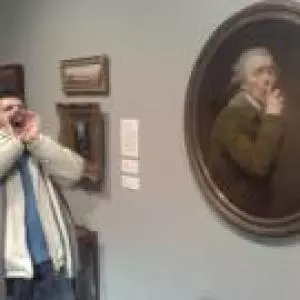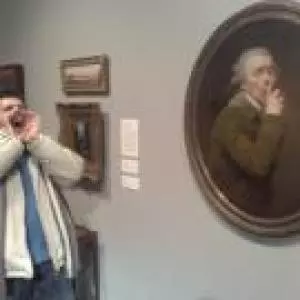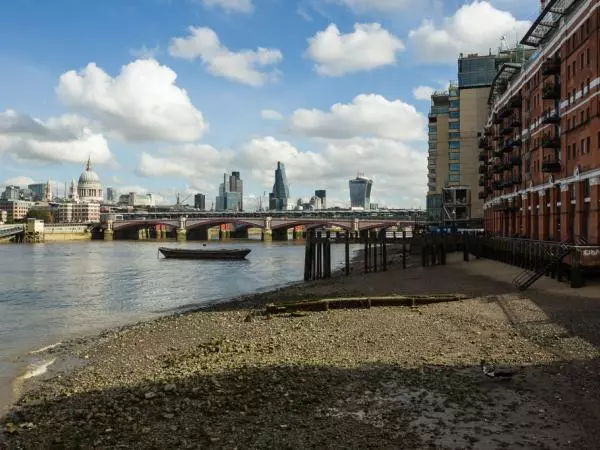
Reflections on the end of modernity and the death of art
The current situation
The French philosopher Jean Baudrillard in an interview in 1996, about a work on the current situation of contemporary art, says: "We can not absolutely predict what will happen in this area, but you must be aware that the Things came to a sort of end point, but where the end does not mean that everything is finished. What was at stake in this modernity has found its end, which for the most part is quite monstrous and absurd, but in which all possibilities have been exhausted and worn out, or are about to be ... " . Talk about the end of art have continued for long in an atmosphere of malaise and decadence in the art world, where chaos reigns for the most part. There is a widespread impression that "all things were made" that there is no possibility for contemporary art development over the nth remakes that seem to reproduce the forms and modes of expression already seen over the past fifty years, exhausted by endless variations and contamination , while the evaluation of the works seem more swayed by that momentary fashions dall'enfasi proven results. On the other hand, the general public seems largely uninterested in contemporary art, seen with suspicious eyes, sometimes with curiosity, increasingly disengaged distracted from the game of mass entertainment. Art lovers seems to be directed toward the distant past or to the artists and works of early modernity, has long been acquired. However in contemporary art is still in an increasingly hurried to set up exhibitions in private galleries and public spaces, organize exhibitions, museums are being built, print books and magazines, while the number of artists seems to grow day by days, and collectors, but complained in a chronic crisis, continue to seek to purchase works. It seems that the art system coasting with the severed head, now in convulsions of the last nerve spasms, and as in any social decadence generate monstrous forms and hypertrophic. In this scenario, beyond the worst signs of pessimism that it grasps the end of the world, or scientistic optimism to think that a new era where art is superfluous, survives in a deep sense opposite to that which it seems impossible 'Art can really have reached its end. Something tells us that the irrational man can never fail to express, that art must necessarily accompany it, even in the worst vicissitudes of becoming. Baudrillard himself, who presents himself as one who wants to without fear "face reality", this leaves open the window of opportunity concluding, "... But where the end does not mean that everything is over, "as Gadamer says," The end of art is always the beginning of a new art. '(4) The issue of contemporary art is apparently inextricable, but for understand the critical situation which has come to be necessary to look at things from a perspective that involves the whole horizon of the ongoing transformation of Western culture, and therefore above the maze in which the same contemporary art, with its ideologies and paradigms is forced and imprisoned.
The death of art
The first one was realized that it was over it was Hegel, as everyone knows. When he speaks of "death of art" says something very profound beyond what usually is repeated more simply: he realizes that art, now at the age of knowledge, no longer has a function.
Hegel at the beginning of the nineteenth century had prophesied in a sort of aesthetic lessons of overcoming art, for which he was awarded the concept that resonates long as a slogan: "the death of art". In fact, the German philosopher interprets art as intermediate grade of the process of self-consciousness of absolute Spirit, that is, as its expression momentarily convoluted, where the idea, expressed in a tangible form, however, is devoid of the concept, realization of supreme knowledge. This conception of the progressive life of the Spirit leads Hegel to think also become the aesthetic expression through a "progress" of art forms. There is first a symbolic form of primitive and archaic feature in which the Idea "is still vague and lacking in clarity", from where the art comes to a classic form where the idea is realized in an exemplary way taking natural beauty. But the achievement of the classical form, which also marks the limit of infinite Spirit have to overcome to complete. The romantic form is this excess that undermines the art of the perfect union between Idea and nature in which the infinite Spirit had found its limitations, projecting beyond itself. "The death of art" is placed at this stage which Hegel sees in the romantic works of art of his time, the sign of the end of the process of expression of the Spirit in the form of art, to prophesy a new age where the concept is made expression of the idea in his infinity. The art in this way is considered a "thing of the past" activities exceeded by the thought, the artists create works of this is not really new, as steps towards the perfection of art have all been made and that can not be imitated, subjectively adhering to past models. The art is so according to Hegel's vision of a secondary form of Western culture.
End of Modernity
Two centuries have passed and these are certainly interesting insights of Hegel to interpret what happened in the meantime. If we think in fact the nineteenth century, a century in which we see mixing romance and academic classicism, symbolism and realism of any kind, it seems that the stagnation predicted by the philosopher has actually occurred. Just as modern art could be interpreted, following this logic, as a further fragmentation of the models, triggering a self-destructive process in which recreates the "death of art" that marks the end of an era. The vision that puts the art as primitive or naive way to represent and give meaning to existence is already found in philosophy from its origins, when Plato's ideal city excludes from artists and poets, the promulgators of that chaos of passions that philosophy but wants dominating. The long rationalist tradition, which from Socrates through and pervades Western culture, which emphasizes the concept of the primary element of knowledge and foundational structure of reality. A culture in the Renaissance, with the modern age, traces the foundations of the planned total rationalization and scientific control of life, which to this day come to an early realization. The nineteenth century opened with the fact of a great prophecy Hegelian bright future-oriented performance of an era and the Idea of R03;R03;science, yet we know that things did not go exactly like this: the Twentieth Century has been subjected to the collapses of totalitarianism built on those structures of thought, while the prodigious scientific and technological progress, which has revolutionized the life of the globe in recent years seems to have taken the man's hand by triggering a process of exponential intensification of the competition at all levels, which poses as a blind objective of profit and power. With the growth of the discomforts of civilization scientistic and technological advances that a new cultural front since the late nineteenth century had laid its foundations in the work of great philosophers such as Schopenhauer, Kierkegaard and Nietzsche in particular, that puts into question the monolithic construction of Western thought, undermining the foundations. The unwavering, absolute validity on which our culture is built based on the structure of metaphysical concepts, begins to falter. Hegelian idealism suffers the harshest criticism and philosophy at the same time, the decisive breach in the fortifications of rationalism and determinism is opened by science in the first decades of the twentieth century undermines the traditional Cartesian and Newtonian for a radically new vision in which mechanistic principle is superseded by quantum theory. The universe, traditionally conceived as a great machine coordinated by a causal system of which the atoms form the foundation, in fact turns out to be energy unitary entity whose parts are connected simultaneously, in which atoms and molecules are not that special energy density that consciousness, as some theories argue, result in sensory experience becoming a constitutive element of the same material. Rational thought hitherto secure its control of an objective reality falters, every field of knowledge is shaken to its foundations, and the psychology of Freud and Jung notes with the dark side of consciousness, where instincts and drives, removed or deformed, inadvertent act on psychic life, changing the perception of reality. The nature, harnessed, bent and exploited, it seems overwhelmingly recover from the depths of man himself, to rebel and react disseminating the psychic distress, and environmental destruction caused by disasters disrupt large areas of the planet. Measured, pigeonhole and dissected for centuries, nature comes back to reveal his enigmatic essence, the man who thought he had reduced it to being able to use them, must now reassemble groped to upset the balance, on pain of its own destruction. In this threat, already active in the assault, there is the real theme of the "end of modernity", the limit of the now full-blown rationalist philosophy of science and determinist. However, if we can assert that the West is changing day by day in this direction, in what has been called postmodern culture, remains obscure the principle on which to build an alternative way to the domain of pure reason, we see progressively lose consistency and credibility with the project, a derivative thereof, a continuous increase of material wealth, the wealth and power. Alternative routes in fact, that in human history have been the civilization: religion and art, which shows how existentialist culture avenues, in the West seem to dramatically involved in the same crisis and decline of the concept. While we talked about a hypothetical "death of art", the other an equally find in our world crisis of religious vocation, in a climate of widespread loss of faith. And 'this bleak scene that generates the bleak climate of our time, the decline of modernity, with stretches of despair hidden under the nervous excitement of big business, travel, events and gatherings of all kinds.
The paradox of art
In this historical moment the art is thus at the heart of a paradox. On the one hand it identifies culture existentialist art as a major element in which to direct the search for meaning, the other the factual situation sees contemporary art involved in a crisis without prospects, the sword of Damocles of the Hegelian prophecy. For some philosophers, existentialist art would be the way in which human beings can rebuild the integrity of the rationalist culture compromised by implementing the "rapprochement being" promulgated by Heidegger as a reintegration of the origin of man and civilization. The art in this sense is seen as an activity whose language preserves the totality of the existential, made much of thought, dream and imagination, because of perceptions materials and instinctual drives. And 'This is the closest expression of true being, that essence that existentialists considered inseparable from human life, as opposed to the conception of that philosophy ever since Socrates has placed in the Idea and concept. The paradox in which contemporary art is to find such a reduction would seem to depend on being part of Western culture, namely the fact that he transferred the whole meaning of life - art included - a map of concepts and metaphysical mental images, to which we have gradually accustomed as they were life itself. This production captures the contemporary left: And 'the work of the critic who authenticates the work of art, not a work of art that comes before the critic. And 'the logic of the historical-critical culture that determines reduced to minimal and not a work of art that is later to make it known. If things are really that the current crisis in the art would have little to do with the "death of art" prophesied by Hegel, which is seen as assets exceeded, but coincides with the end of the metaphysical concept, and therefore with the end of the philosophical, linguistic and historicist art in which we are immersed and with which most of the artists, consciously or unconsciously, has long operated


 Share / Save
Share / Save





Comments 1
Say something